Aerospace technology is one of the most compelling technologies in the world since the early 20th century. The energy used by modern aircraft engines is still the traditional petroleum products "aviation gasoline" (for aviation piston engines) and "aviation kerosene" (for turbojet engines). The fuel consumption of aero-engines flying in the air is very alarming. For example, the Boeing 747 consumes 11 tons of fuel per hour. If Boeing 747 flies from Harbin to Guangzhou, it will consume about 50 tons of fuel. In addition to the massive consumption of limited petroleum resources, the pollution of jet engine residues to the atmosphere and the interference of noise on the living environment are also serious problems.
People are looking for new green energy for aviation, such as solar energy for aircraft to provide a new way for aviation energy. Solar-powered aircraft can complete a long flight without using a drop of oil, and at low cost, they can obtain energy for free.
1 Solar cellAs early as more than 100 years ago, people began to study the effect of light energy on electricity. Solar cells are devices that directly convert light energy into electrical energy through the photoelectric effect or photochemical effect. In 1958, the United States developed the first n / p type monocrystalline silicon solar photovoltaic cell and used it for satellite power supply. The sun illuminates the semiconductor pn junction to form a new hole-electron pair. Under the action of the electric field of the pn junction, photogenerated holes flow from the n region to the p region, and photogenerated electrons flow from the p region to the n region. Current. This is how the photovoltaic effect solar cell works (Figure 1). The production of solar cells requires a complicated process (Figure 2). Due to its excellent characteristics such as high conversion efficiency, working stability, long life, mature technology development, etc., crystalline silicon solar cells currently have the most applications in the photovoltaic market. UAVs have put forward higher requirements for solar cells in terms of weight, thickness, flexibility and efficiency.
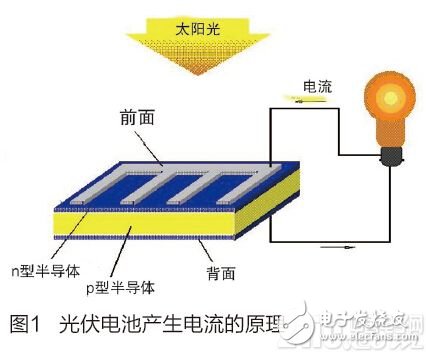
As early as the middle of the 20th century, people sought to design an aircraft that used solar radiation as propulsion energy. The power plant of a solar aircraft consists of a solar battery, a DC motor, a propeller, and a control device. Since the energy density of solar radiation is small, in order to obtain sufficient energy, the aircraft should have a large surface area to absorb sunlight in order to lay solar cells.
The world's first solar drone was designed by RJ Boucher of American AstroFlight company. The drone is named "Sunrise I". The total weight of the aircraft is 27.5Ibs, the wingspan is 32ft, a total of 4096 solar panels are used, and the power is 450W. On November 4, 1974, a test flight in California, USA, the drone flew at an altitude of about 100m for about 20 minutes. He then designed and developed an improved solar drone "Sunrise II". The drone has a total weight of 22.5Ibs, a wingspan of 32ft, and a wing area of ​​90ft2. It flew for the first time on September 12, 1975, using new solar panels, which is more efficient than the first drone 14%, the total power has reached 600W.
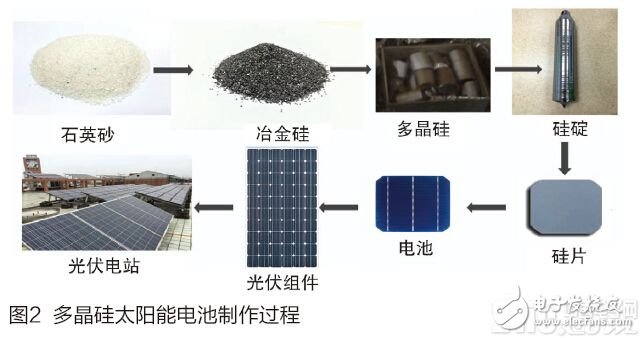
Solar drones are usually designed with large aspect ratio wings, which can obtain a large lift-drag ratio (lift-to-drag ratio). On the one hand, more solar panels can be laid on the upper surface of the wing. On the other hand In the case of carrying the necessary weight of the UAV to reduce drag and reduce the consumption of power energy (electric energy converted from solar energy).
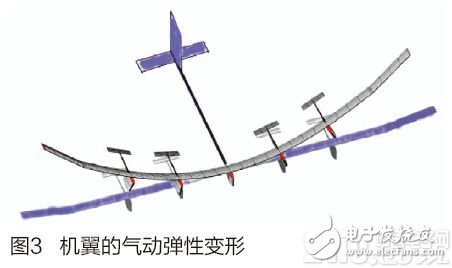
In order to reduce energy consumption, the solar drone structure is designed to be lighter than ordinary drones, while ensuring sufficient strength. At present, the structure (skeleton, skin) is mostly made of lightweight non-metallic materials, of which the main load-bearing structure usually uses carbon fiber composite materials. Carbon fiber resin composite materials are not only light in weight, but also have high specific strength, specific modulus, fatigue resistance, corrosion resistance, and good forming processability.
Due to the long and light structure of the solar UAV, the rigidity of the slender wing structure is small. The interaction between the aerodynamics of the drone flight and the elastic structure of the drone body is called "aeroelasticity". At higher flight speeds, the aerodynamic forces (including aerodynamic moments) and structural deformation on the wing of the UAV will become larger and larger. When the flight speed reaches a certain value, "static aeroelastic divergence" or " "Flutter", causing the wing or fuselage to break. The early "Apollo" drones in the United States once disintegrated in the air due to the aeroelastic deformation of the wings.
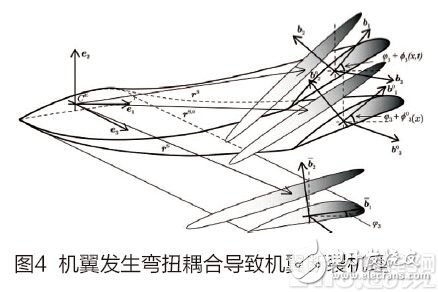
Therefore, the structure of solar drones should be carefully designed, for example, the adverse effects of aeroelasticity (interaction between aerodynamic and elastic structures) and gust response problems can be overcome through the optimized design of carbon fiber layup distribution and layup direction To avoid the occurrence of "aeroelastic divergence" and "flutter" of the unmanned aerial vehicle structure, and prevent the structure from deforming and breaking.
3.3 Solar cells suitable for dronesSolar cells are the source of power for solar drones. The solar cells suitable for drones are different from the solar cells used daily in photovoltaic power stations and households. Solar cells for drones not only require light weight and thin thickness, but also need to have a certain degree of flexibility in order to be laid on the outer surface of the wing or other body.
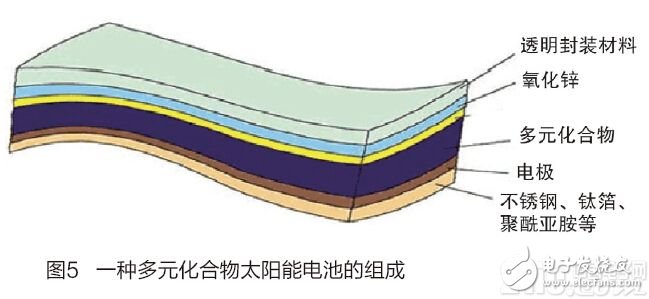
Solar cells can be divided into two types according to the crystalline state: crystalline thin-film type and non-crystalline thin-film type.
Solar cells can be divided into: silicon crystal batteries (single crystal, polycrystalline, amorphous silicon), multi-component compound thin-film batteries, polymer multilayer modified electrode type batteries, nanocrystalline batteries.
At present, most of the solar aircraft used are thin-film monocrystalline silicon solar cells and flexible thin-film multi-component compound batteries (such as gallium arsenide thin-film batteries, copper indium gallium selenium thin-film batteries, etc.). The preparation process of flexible thin-film solar cells is very complicated. For example, multi-component compound batteries need to undergo fine processing processes such as reactive sputtering, thermal evaporation, cleaning, laser cutting and packaging. In order to be suitable for installation on the surface of a drone, the solar cell needs to be light, thin and soft, and the battery package must have excellent waterproof steam performance, and also need to have functions such as anti-ultraviolet, anti-wear, and anti-aging.
The efficiency of solar cells is the basis for determining the power and carrying capacity of solar aircraft. The so-called conversion efficiency of the solar panel refers to the ratio of the output power density of the battery to the incident optical power density, that is, the efficiency of the solar panel of a certain area can be converted into electrical energy after absorbing light energy. At present, the efficiency of solar panels is usually 10% -30%, so it is necessary to continuously improve the efficiency of solar panels to reduce the area of ​​the aircraft or increase the weight.
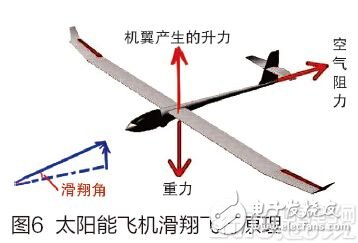
Solar drones need to achieve continuous flight day and night. In the absence of sunlight at night, the energy storage system must be used to store the excess energy converted from solar energy absorbed during the day (such as lithium batteries) for night flight. Night drone flight must perform a different flight mode than during the day. At night, in order to save energy, a combination of unpowered "gliding flight" and powered flight is usually adopted. Because solar drones have large aspect ratio wings and light structural characteristics, they have excellent gliding capabilities. When the UAV is flying at a certain glide angle, due to the "angle of attack" generated by the relative airflow, even if there is no power, a certain lift will be generated, thereby saving energy. Of course, solar drones must have advanced autonomous control flight and navigation capabilities. Night flight also requires the drone to be designed with functions such as an automatic control program to perform glide flight and automatic conversion between different flight modes.
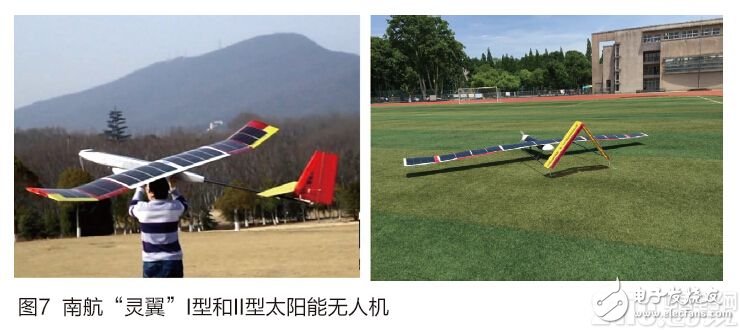
Solar drones, like other drones, require advanced electronic systems. At present, people generally accept the concept proposed by the United States in the "Unmanned Aircraft System Roadmap", and use the "UAS: Unmanned Aircraft System" instead of the original "UAV". In other words, usually we say "drones", which should be short for "drones system". The UAV system refers to the UAV air platform and its supporting mission equipment, data link, ground measurement and control station, takeoff (launch) recovery device and ground support equipment.
The UAV's autonomous flight control and navigation system includes control of a variety of sensors and microprocessors, satellite navigation receivers, execution of aircraft attitude control and planned route navigation control, and is currently developing to intelligent control.
UAV information transmission system broadly includes mission load sensors and information transmission. The mission payload is different airborne mission equipment designed according to the micro aircraft of different mission missions, such as reconnaissance equipment, electronic jammers, gas collectors, sound sensors and other mission sensors. Generally, the vision sensor is the most basic mission sensor of a drone. It also includes the control of the task equipment, such as the rotation platform of the task equipment and the tracking target control module. Information transmission includes data processing of airborne information and ground information.
Due to the longer flight time and the need to adapt to day and night flight and other environmental impacts, solar drones require higher functionality and reliability of electronic systems.
4 Development of solar dronesBecause solar drones have the advantages of long flight time and non-polluting energy, their development has been valued by various countries. At present, solar drones are mainly planned for high-altitude long-distance reconnaissance or surveillance, and can continuously reconnaissance in the sky and tens of thousands of meters to partially replace the function of reconnaissance satellites. The more famous solar drone is the "Apollo" drone developed by AeroVironment, a company sponsored by NASA. The aircraft has a rectangular flying wing layout with a wingspan of 75 meters and a length of 2.4 meters. Equipped with 65,000 solar cells, it can provide 40 kilowatts of electric power to drive 14 propellers. It can fly at a cruising speed of 30 to 50 kilometers per hour. After 10 hours and 17 minutes of flight, it can reach an altitude of 22800 meters. In 2013, the United States TItan Aerospace launched two solar solar drones: Type 50 and Type 60, planning to fly for 5 years in a row.
There are other large solar drones as listed in Table 1. The development of a variety of small solar drones in the world is more active, among which the successful long-endurance flight tests are shown in Table 2.
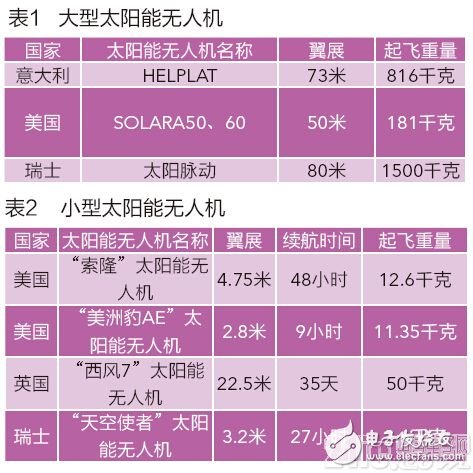
The British "Westwind 7" solar drone is currently the longest continuously flying unmanned aerial vehicle. It is taken off by 3 to 4 people. The maximum flight height can reach 40,000 meters, and the endurance time has reached 35 days. High-altitude, accurate shooting of ground targets with a size of only 25.4 cm.
There are also many units in China that are developing a variety of solar drones. Figure 7 is the "Spirit Wing" small solar drone developed by Nanjing University of Aeronautics and Astronautics, with a wingspan of 4.5 meters and 6 meters. Among them, the "Ling Wing" type II wing can also be partially deformed to increase the sunlight. strength. These two UAVs are equipped with excellent performance copper-indium-gallium-selenium flexible thin-film solar cells, which have achieved long-term flight that only depends on solar energy.
As the demand for new energy and the continuous development of solar cell technology, solar aircraft will continue to increase its flight capacity and load capacity. Solar vehicles have evolved from drones to solar manned aircraft. The "Sunshine Power 2" manned solar aircraft developed by the Swiss Sunshine Power Company is flying around the world. The wing of the aircraft is equipped with 17,000 ultra-thin and efficient solar panels, with a wingspan of 72 meters, an average speed of 50 to 100 kilometers per hour, a maximum flight altitude of 8,500 meters, a weight of 2,300 kilograms, and a crew. It can fly continuously during the day and night, and has achieved continuous flight for 80 hours. The "Sunshine Power" company predicts that after more than 30 years, an all-solar aircraft capable of carrying 300 passengers is expected to be officially put into operation. Mankind will truly realize the dream of fuel-free and environmentally friendly flight. In the future, space-based unmanned solar power plants can also be established in space to continuously supply electricity to the earth.
Android Wi-Fi Tablet,Tablet Computer,Pcs Tablets,Tablet Pc Android
C&Q Technology (Guangzhou) Co.,Ltd. , https://www.gzcqteq.com